EU Competitive Instruments
VerifiedAdded on 2023/06/04
|13
|3639
|441
AI Summary
The European Union aims to remove obstacles between member states and prevent their recurrence. The main EU competition instruments include mergers, state aid control, fight on cartels and antitrust rules. The member states have a major role in harmonizing their policies to match the EU policies.
Contribute Materials
Your contribution can guide someone’s learning journey. Share your
documents today.
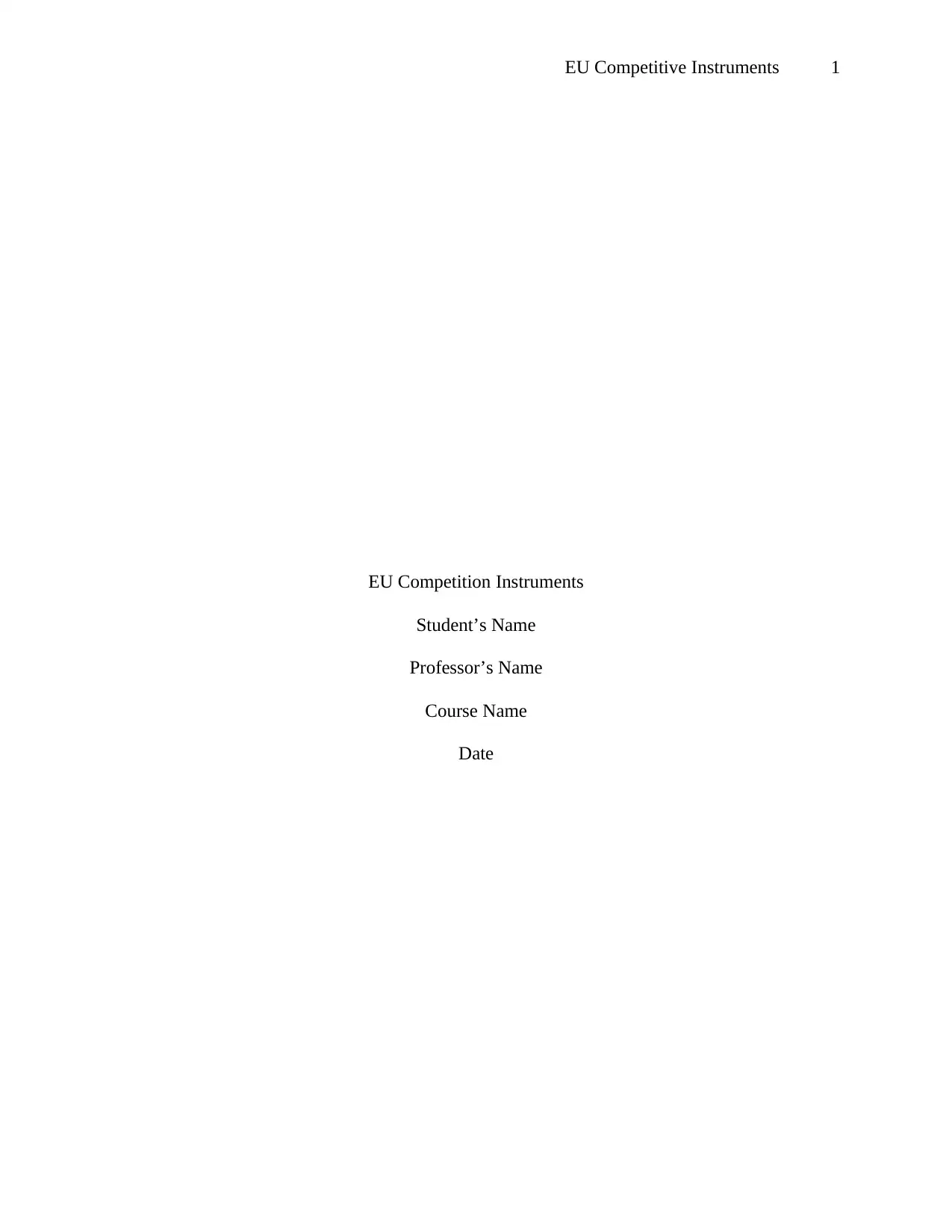
EU Competitive Instruments 1
EU Competition Instruments
Student’s Name
Professor’s Name
Course Name
Date
EU Competition Instruments
Student’s Name
Professor’s Name
Course Name
Date
Secure Best Marks with AI Grader
Need help grading? Try our AI Grader for instant feedback on your assignments.
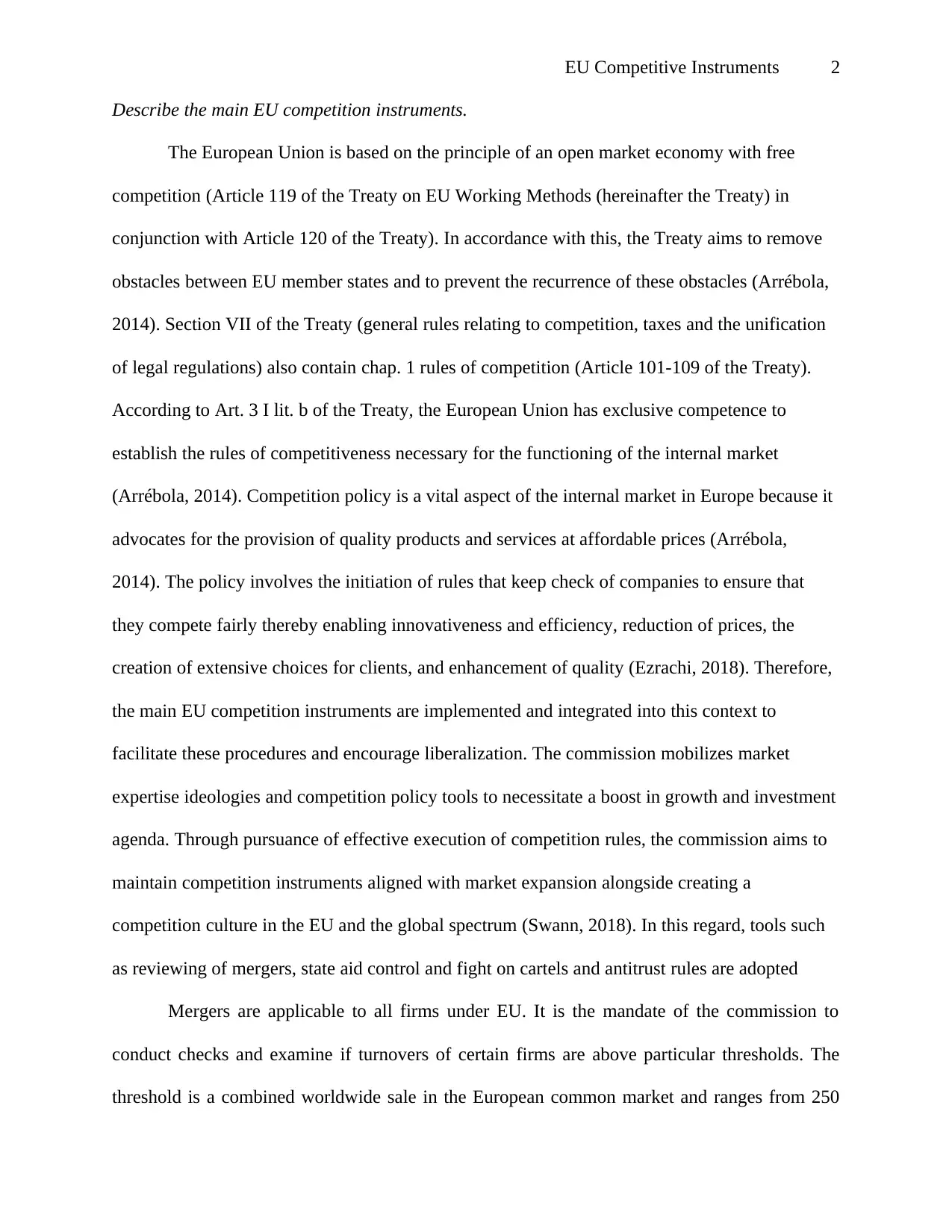
EU Competitive Instruments 2
Describe the main EU competition instruments.
The European Union is based on the principle of an open market economy with free
competition (Article 119 of the Treaty on EU Working Methods (hereinafter the Treaty) in
conjunction with Article 120 of the Treaty). In accordance with this, the Treaty aims to remove
obstacles between EU member states and to prevent the recurrence of these obstacles (Arrébola,
2014). Section VII of the Treaty (general rules relating to competition, taxes and the unification
of legal regulations) also contain chap. 1 rules of competition (Article 101-109 of the Treaty).
According to Art. 3 I lit. b of the Treaty, the European Union has exclusive competence to
establish the rules of competitiveness necessary for the functioning of the internal market
(Arrébola, 2014). Competition policy is a vital aspect of the internal market in Europe because it
advocates for the provision of quality products and services at affordable prices (Arrébola,
2014). The policy involves the initiation of rules that keep check of companies to ensure that
they compete fairly thereby enabling innovativeness and efficiency, reduction of prices, the
creation of extensive choices for clients, and enhancement of quality (Ezrachi, 2018). Therefore,
the main EU competition instruments are implemented and integrated into this context to
facilitate these procedures and encourage liberalization. The commission mobilizes market
expertise ideologies and competition policy tools to necessitate a boost in growth and investment
agenda. Through pursuance of effective execution of competition rules, the commission aims to
maintain competition instruments aligned with market expansion alongside creating a
competition culture in the EU and the global spectrum (Swann, 2018). In this regard, tools such
as reviewing of mergers, state aid control and fight on cartels and antitrust rules are adopted
Mergers are applicable to all firms under EU. It is the mandate of the commission to
conduct checks and examine if turnovers of certain firms are above particular thresholds. The
threshold is a combined worldwide sale in the European common market and ranges from 250
Describe the main EU competition instruments.
The European Union is based on the principle of an open market economy with free
competition (Article 119 of the Treaty on EU Working Methods (hereinafter the Treaty) in
conjunction with Article 120 of the Treaty). In accordance with this, the Treaty aims to remove
obstacles between EU member states and to prevent the recurrence of these obstacles (Arrébola,
2014). Section VII of the Treaty (general rules relating to competition, taxes and the unification
of legal regulations) also contain chap. 1 rules of competition (Article 101-109 of the Treaty).
According to Art. 3 I lit. b of the Treaty, the European Union has exclusive competence to
establish the rules of competitiveness necessary for the functioning of the internal market
(Arrébola, 2014). Competition policy is a vital aspect of the internal market in Europe because it
advocates for the provision of quality products and services at affordable prices (Arrébola,
2014). The policy involves the initiation of rules that keep check of companies to ensure that
they compete fairly thereby enabling innovativeness and efficiency, reduction of prices, the
creation of extensive choices for clients, and enhancement of quality (Ezrachi, 2018). Therefore,
the main EU competition instruments are implemented and integrated into this context to
facilitate these procedures and encourage liberalization. The commission mobilizes market
expertise ideologies and competition policy tools to necessitate a boost in growth and investment
agenda. Through pursuance of effective execution of competition rules, the commission aims to
maintain competition instruments aligned with market expansion alongside creating a
competition culture in the EU and the global spectrum (Swann, 2018). In this regard, tools such
as reviewing of mergers, state aid control and fight on cartels and antitrust rules are adopted
Mergers are applicable to all firms under EU. It is the mandate of the commission to
conduct checks and examine if turnovers of certain firms are above particular thresholds. The
threshold is a combined worldwide sale in the European common market and ranges from 250
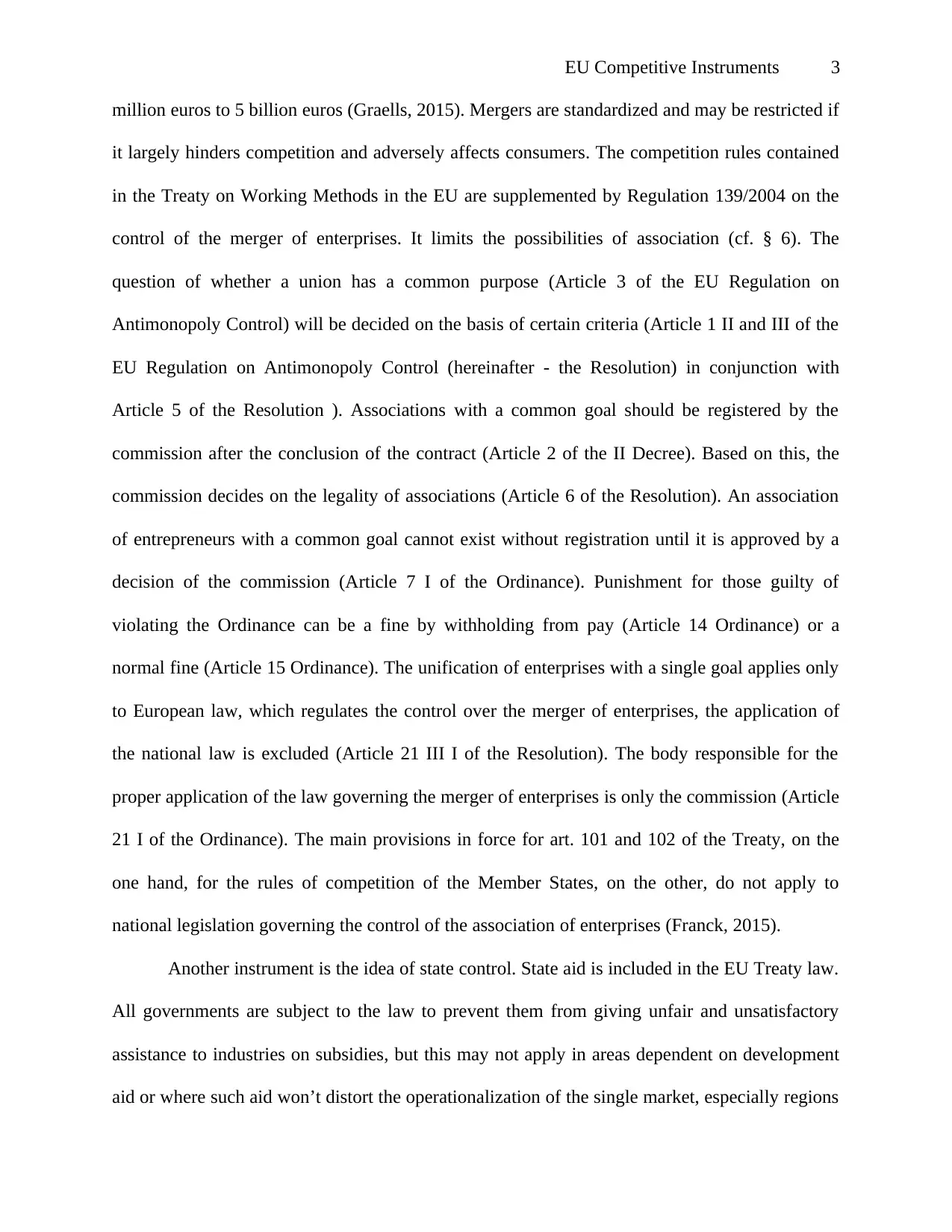
EU Competitive Instruments 3
million euros to 5 billion euros (Graells, 2015). Mergers are standardized and may be restricted if
it largely hinders competition and adversely affects consumers. The competition rules contained
in the Treaty on Working Methods in the EU are supplemented by Regulation 139/2004 on the
control of the merger of enterprises. It limits the possibilities of association (cf. § 6). The
question of whether a union has a common purpose (Article 3 of the EU Regulation on
Antimonopoly Control) will be decided on the basis of certain criteria (Article 1 II and III of the
EU Regulation on Antimonopoly Control (hereinafter - the Resolution) in conjunction with
Article 5 of the Resolution ). Associations with a common goal should be registered by the
commission after the conclusion of the contract (Article 2 of the II Decree). Based on this, the
commission decides on the legality of associations (Article 6 of the Resolution). An association
of entrepreneurs with a common goal cannot exist without registration until it is approved by a
decision of the commission (Article 7 I of the Ordinance). Punishment for those guilty of
violating the Ordinance can be a fine by withholding from pay (Article 14 Ordinance) or a
normal fine (Article 15 Ordinance). The unification of enterprises with a single goal applies only
to European law, which regulates the control over the merger of enterprises, the application of
the national law is excluded (Article 21 III I of the Resolution). The body responsible for the
proper application of the law governing the merger of enterprises is only the commission (Article
21 I of the Ordinance). The main provisions in force for art. 101 and 102 of the Treaty, on the
one hand, for the rules of competition of the Member States, on the other, do not apply to
national legislation governing the control of the association of enterprises (Franck, 2015).
Another instrument is the idea of state control. State aid is included in the EU Treaty law.
All governments are subject to the law to prevent them from giving unfair and unsatisfactory
assistance to industries on subsidies, but this may not apply in areas dependent on development
aid or where such aid won’t distort the operationalization of the single market, especially regions
million euros to 5 billion euros (Graells, 2015). Mergers are standardized and may be restricted if
it largely hinders competition and adversely affects consumers. The competition rules contained
in the Treaty on Working Methods in the EU are supplemented by Regulation 139/2004 on the
control of the merger of enterprises. It limits the possibilities of association (cf. § 6). The
question of whether a union has a common purpose (Article 3 of the EU Regulation on
Antimonopoly Control) will be decided on the basis of certain criteria (Article 1 II and III of the
EU Regulation on Antimonopoly Control (hereinafter - the Resolution) in conjunction with
Article 5 of the Resolution ). Associations with a common goal should be registered by the
commission after the conclusion of the contract (Article 2 of the II Decree). Based on this, the
commission decides on the legality of associations (Article 6 of the Resolution). An association
of entrepreneurs with a common goal cannot exist without registration until it is approved by a
decision of the commission (Article 7 I of the Ordinance). Punishment for those guilty of
violating the Ordinance can be a fine by withholding from pay (Article 14 Ordinance) or a
normal fine (Article 15 Ordinance). The unification of enterprises with a single goal applies only
to European law, which regulates the control over the merger of enterprises, the application of
the national law is excluded (Article 21 III I of the Resolution). The body responsible for the
proper application of the law governing the merger of enterprises is only the commission (Article
21 I of the Ordinance). The main provisions in force for art. 101 and 102 of the Treaty, on the
one hand, for the rules of competition of the Member States, on the other, do not apply to
national legislation governing the control of the association of enterprises (Franck, 2015).
Another instrument is the idea of state control. State aid is included in the EU Treaty law.
All governments are subject to the law to prevent them from giving unfair and unsatisfactory
assistance to industries on subsidies, but this may not apply in areas dependent on development
aid or where such aid won’t distort the operationalization of the single market, especially regions
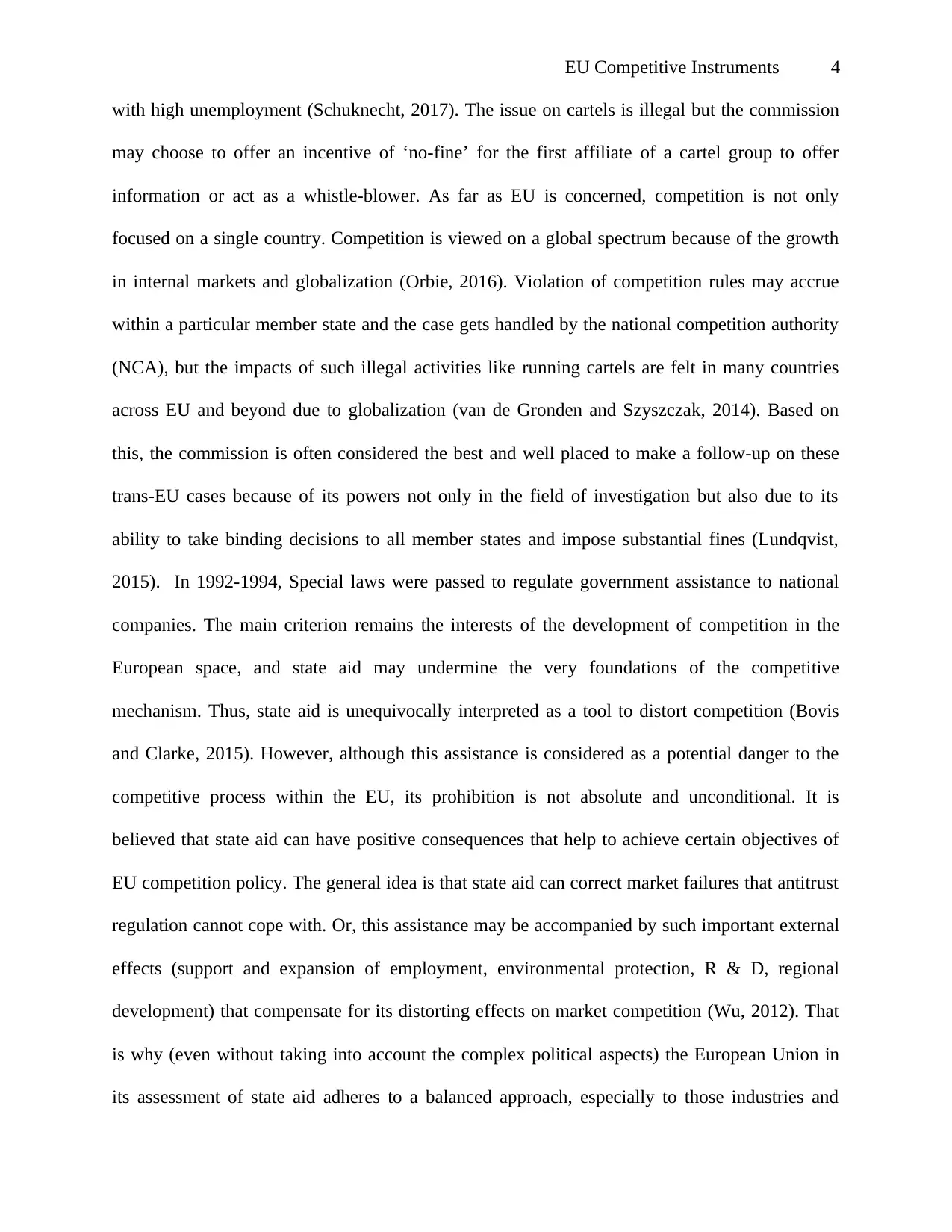
EU Competitive Instruments 4
with high unemployment (Schuknecht, 2017). The issue on cartels is illegal but the commission
may choose to offer an incentive of ‘no-fine’ for the first affiliate of a cartel group to offer
information or act as a whistle-blower. As far as EU is concerned, competition is not only
focused on a single country. Competition is viewed on a global spectrum because of the growth
in internal markets and globalization (Orbie, 2016). Violation of competition rules may accrue
within a particular member state and the case gets handled by the national competition authority
(NCA), but the impacts of such illegal activities like running cartels are felt in many countries
across EU and beyond due to globalization (van de Gronden and Szyszczak, 2014). Based on
this, the commission is often considered the best and well placed to make a follow-up on these
trans-EU cases because of its powers not only in the field of investigation but also due to its
ability to take binding decisions to all member states and impose substantial fines (Lundqvist,
2015). In 1992-1994, Special laws were passed to regulate government assistance to national
companies. The main criterion remains the interests of the development of competition in the
European space, and state aid may undermine the very foundations of the competitive
mechanism. Thus, state aid is unequivocally interpreted as a tool to distort competition (Bovis
and Clarke, 2015). However, although this assistance is considered as a potential danger to the
competitive process within the EU, its prohibition is not absolute and unconditional. It is
believed that state aid can have positive consequences that help to achieve certain objectives of
EU competition policy. The general idea is that state aid can correct market failures that antitrust
regulation cannot cope with. Or, this assistance may be accompanied by such important external
effects (support and expansion of employment, environmental protection, R & D, regional
development) that compensate for its distorting effects on market competition (Wu, 2012). That
is why (even without taking into account the complex political aspects) the European Union in
its assessment of state aid adheres to a balanced approach, especially to those industries and
with high unemployment (Schuknecht, 2017). The issue on cartels is illegal but the commission
may choose to offer an incentive of ‘no-fine’ for the first affiliate of a cartel group to offer
information or act as a whistle-blower. As far as EU is concerned, competition is not only
focused on a single country. Competition is viewed on a global spectrum because of the growth
in internal markets and globalization (Orbie, 2016). Violation of competition rules may accrue
within a particular member state and the case gets handled by the national competition authority
(NCA), but the impacts of such illegal activities like running cartels are felt in many countries
across EU and beyond due to globalization (van de Gronden and Szyszczak, 2014). Based on
this, the commission is often considered the best and well placed to make a follow-up on these
trans-EU cases because of its powers not only in the field of investigation but also due to its
ability to take binding decisions to all member states and impose substantial fines (Lundqvist,
2015). In 1992-1994, Special laws were passed to regulate government assistance to national
companies. The main criterion remains the interests of the development of competition in the
European space, and state aid may undermine the very foundations of the competitive
mechanism. Thus, state aid is unequivocally interpreted as a tool to distort competition (Bovis
and Clarke, 2015). However, although this assistance is considered as a potential danger to the
competitive process within the EU, its prohibition is not absolute and unconditional. It is
believed that state aid can have positive consequences that help to achieve certain objectives of
EU competition policy. The general idea is that state aid can correct market failures that antitrust
regulation cannot cope with. Or, this assistance may be accompanied by such important external
effects (support and expansion of employment, environmental protection, R & D, regional
development) that compensate for its distorting effects on market competition (Wu, 2012). That
is why (even without taking into account the complex political aspects) the European Union in
its assessment of state aid adheres to a balanced approach, especially to those industries and
Secure Best Marks with AI Grader
Need help grading? Try our AI Grader for instant feedback on your assignments.
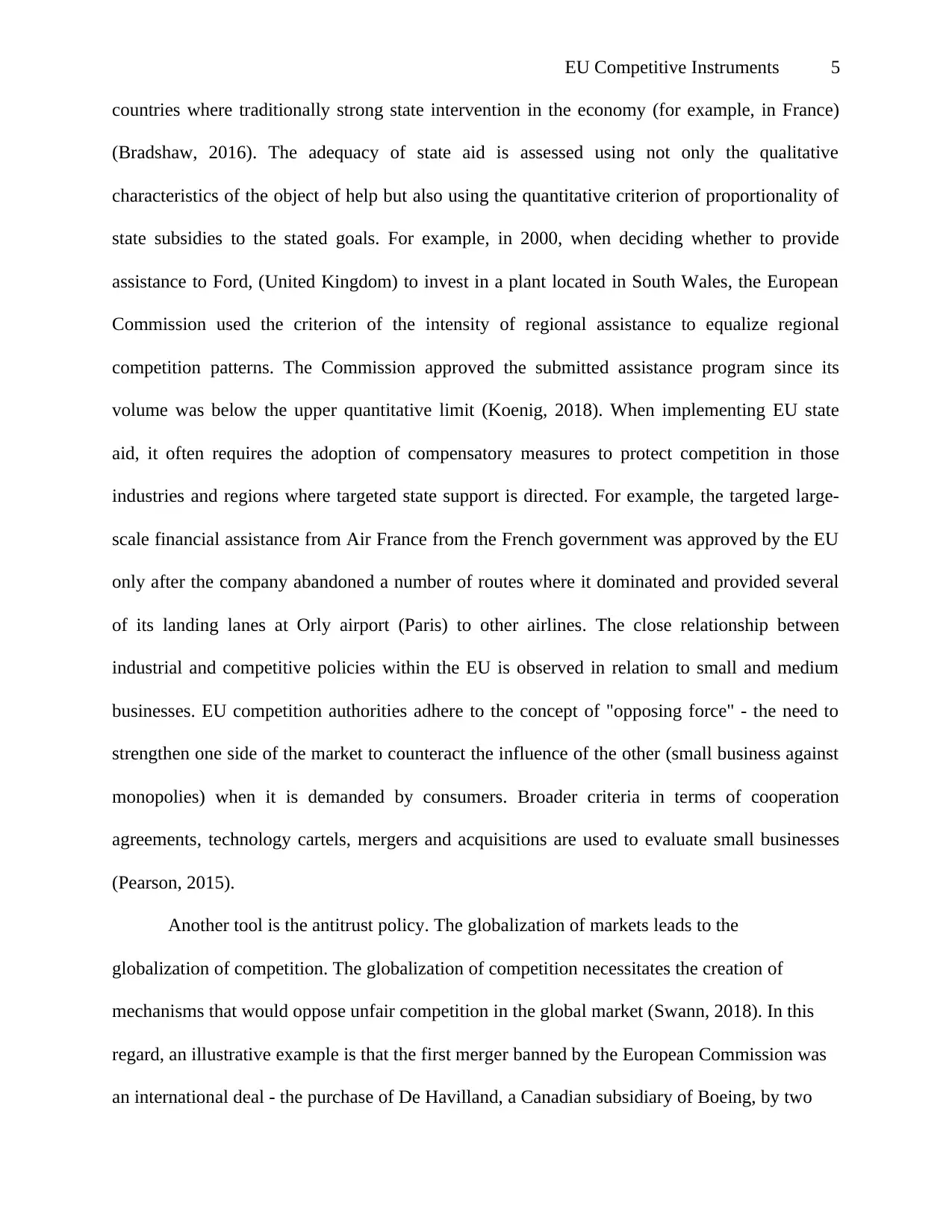
EU Competitive Instruments 5
countries where traditionally strong state intervention in the economy (for example, in France)
(Bradshaw, 2016). The adequacy of state aid is assessed using not only the qualitative
characteristics of the object of help but also using the quantitative criterion of proportionality of
state subsidies to the stated goals. For example, in 2000, when deciding whether to provide
assistance to Ford, (United Kingdom) to invest in a plant located in South Wales, the European
Commission used the criterion of the intensity of regional assistance to equalize regional
competition patterns. The Commission approved the submitted assistance program since its
volume was below the upper quantitative limit (Koenig, 2018). When implementing EU state
aid, it often requires the adoption of compensatory measures to protect competition in those
industries and regions where targeted state support is directed. For example, the targeted large-
scale financial assistance from Air France from the French government was approved by the EU
only after the company abandoned a number of routes where it dominated and provided several
of its landing lanes at Orly airport (Paris) to other airlines. The close relationship between
industrial and competitive policies within the EU is observed in relation to small and medium
businesses. EU competition authorities adhere to the concept of "opposing force" - the need to
strengthen one side of the market to counteract the influence of the other (small business against
monopolies) when it is demanded by consumers. Broader criteria in terms of cooperation
agreements, technology cartels, mergers and acquisitions are used to evaluate small businesses
(Pearson, 2015).
Another tool is the antitrust policy. The globalization of markets leads to the
globalization of competition. The globalization of competition necessitates the creation of
mechanisms that would oppose unfair competition in the global market (Swann, 2018). In this
regard, an illustrative example is that the first merger banned by the European Commission was
an international deal - the purchase of De Havilland, a Canadian subsidiary of Boeing, by two
countries where traditionally strong state intervention in the economy (for example, in France)
(Bradshaw, 2016). The adequacy of state aid is assessed using not only the qualitative
characteristics of the object of help but also using the quantitative criterion of proportionality of
state subsidies to the stated goals. For example, in 2000, when deciding whether to provide
assistance to Ford, (United Kingdom) to invest in a plant located in South Wales, the European
Commission used the criterion of the intensity of regional assistance to equalize regional
competition patterns. The Commission approved the submitted assistance program since its
volume was below the upper quantitative limit (Koenig, 2018). When implementing EU state
aid, it often requires the adoption of compensatory measures to protect competition in those
industries and regions where targeted state support is directed. For example, the targeted large-
scale financial assistance from Air France from the French government was approved by the EU
only after the company abandoned a number of routes where it dominated and provided several
of its landing lanes at Orly airport (Paris) to other airlines. The close relationship between
industrial and competitive policies within the EU is observed in relation to small and medium
businesses. EU competition authorities adhere to the concept of "opposing force" - the need to
strengthen one side of the market to counteract the influence of the other (small business against
monopolies) when it is demanded by consumers. Broader criteria in terms of cooperation
agreements, technology cartels, mergers and acquisitions are used to evaluate small businesses
(Pearson, 2015).
Another tool is the antitrust policy. The globalization of markets leads to the
globalization of competition. The globalization of competition necessitates the creation of
mechanisms that would oppose unfair competition in the global market (Swann, 2018). In this
regard, an illustrative example is that the first merger banned by the European Commission was
an international deal - the purchase of De Havilland, a Canadian subsidiary of Boeing, by two
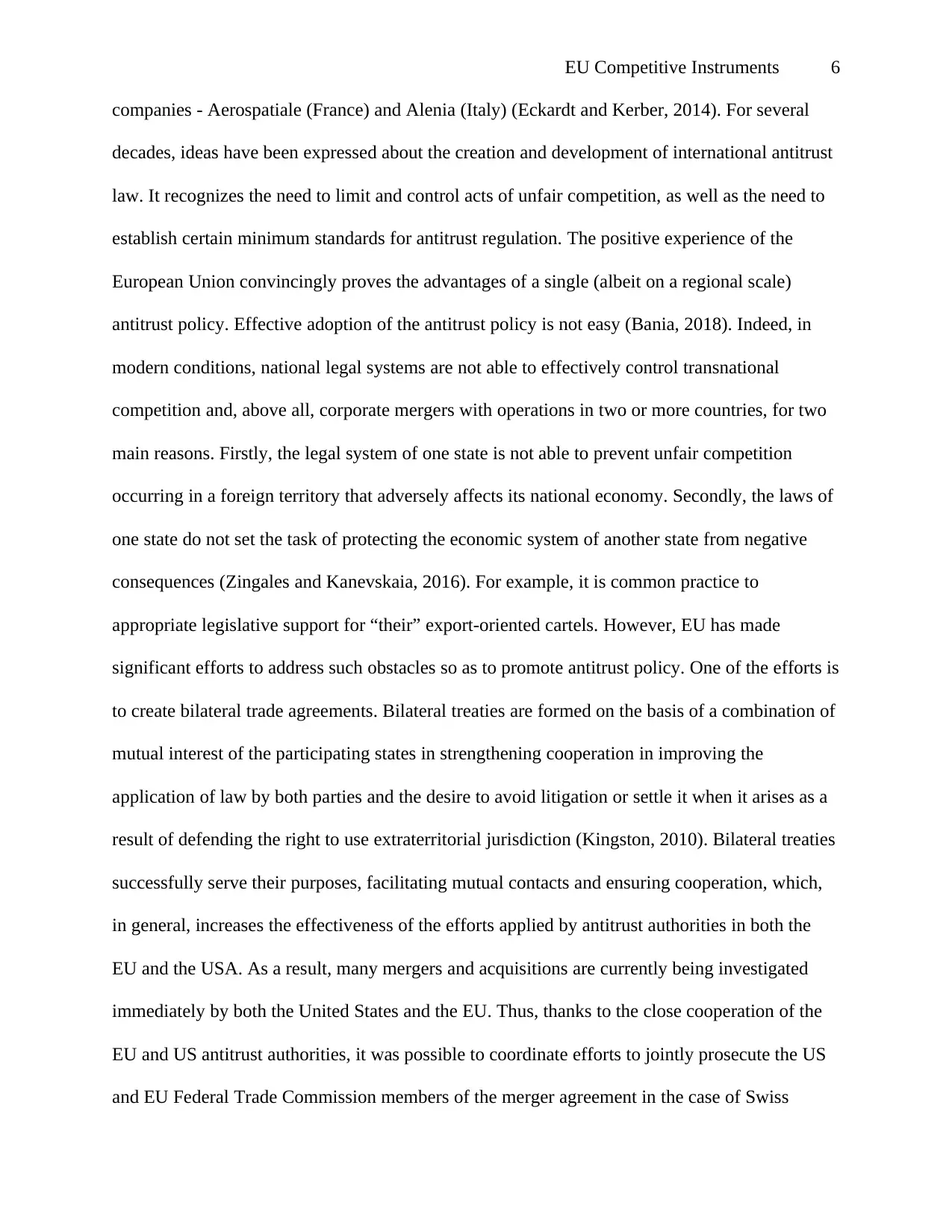
EU Competitive Instruments 6
companies - Aerospatiale (France) and Alenia (Italy) (Eckardt and Kerber, 2014). For several
decades, ideas have been expressed about the creation and development of international antitrust
law. It recognizes the need to limit and control acts of unfair competition, as well as the need to
establish certain minimum standards for antitrust regulation. The positive experience of the
European Union convincingly proves the advantages of a single (albeit on a regional scale)
antitrust policy. Effective adoption of the antitrust policy is not easy (Bania, 2018). Indeed, in
modern conditions, national legal systems are not able to effectively control transnational
competition and, above all, corporate mergers with operations in two or more countries, for two
main reasons. Firstly, the legal system of one state is not able to prevent unfair competition
occurring in a foreign territory that adversely affects its national economy. Secondly, the laws of
one state do not set the task of protecting the economic system of another state from negative
consequences (Zingales and Kanevskaia, 2016). For example, it is common practice to
appropriate legislative support for “their” export-oriented cartels. However, EU has made
significant efforts to address such obstacles so as to promote antitrust policy. One of the efforts is
to create bilateral trade agreements. Bilateral treaties are formed on the basis of a combination of
mutual interest of the participating states in strengthening cooperation in improving the
application of law by both parties and the desire to avoid litigation or settle it when it arises as a
result of defending the right to use extraterritorial jurisdiction (Kingston, 2010). Bilateral treaties
successfully serve their purposes, facilitating mutual contacts and ensuring cooperation, which,
in general, increases the effectiveness of the efforts applied by antitrust authorities in both the
EU and the USA. As a result, many mergers and acquisitions are currently being investigated
immediately by both the United States and the EU. Thus, thanks to the close cooperation of the
EU and US antitrust authorities, it was possible to coordinate efforts to jointly prosecute the US
and EU Federal Trade Commission members of the merger agreement in the case of Swiss
companies - Aerospatiale (France) and Alenia (Italy) (Eckardt and Kerber, 2014). For several
decades, ideas have been expressed about the creation and development of international antitrust
law. It recognizes the need to limit and control acts of unfair competition, as well as the need to
establish certain minimum standards for antitrust regulation. The positive experience of the
European Union convincingly proves the advantages of a single (albeit on a regional scale)
antitrust policy. Effective adoption of the antitrust policy is not easy (Bania, 2018). Indeed, in
modern conditions, national legal systems are not able to effectively control transnational
competition and, above all, corporate mergers with operations in two or more countries, for two
main reasons. Firstly, the legal system of one state is not able to prevent unfair competition
occurring in a foreign territory that adversely affects its national economy. Secondly, the laws of
one state do not set the task of protecting the economic system of another state from negative
consequences (Zingales and Kanevskaia, 2016). For example, it is common practice to
appropriate legislative support for “their” export-oriented cartels. However, EU has made
significant efforts to address such obstacles so as to promote antitrust policy. One of the efforts is
to create bilateral trade agreements. Bilateral treaties are formed on the basis of a combination of
mutual interest of the participating states in strengthening cooperation in improving the
application of law by both parties and the desire to avoid litigation or settle it when it arises as a
result of defending the right to use extraterritorial jurisdiction (Kingston, 2010). Bilateral treaties
successfully serve their purposes, facilitating mutual contacts and ensuring cooperation, which,
in general, increases the effectiveness of the efforts applied by antitrust authorities in both the
EU and the USA. As a result, many mergers and acquisitions are currently being investigated
immediately by both the United States and the EU. Thus, thanks to the close cooperation of the
EU and US antitrust authorities, it was possible to coordinate efforts to jointly prosecute the US
and EU Federal Trade Commission members of the merger agreement in the case of Swiss
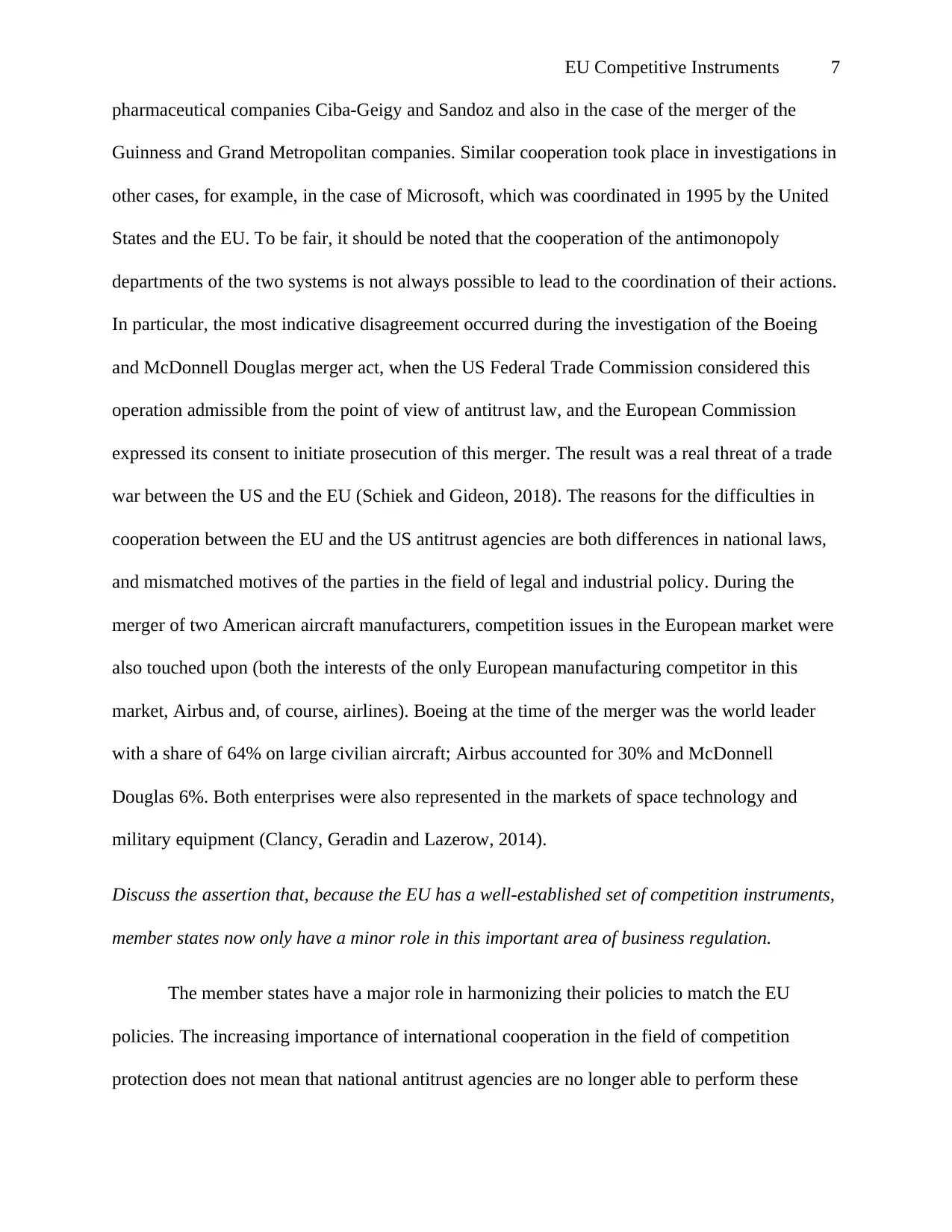
EU Competitive Instruments 7
pharmaceutical companies Ciba-Geigy and Sandoz and also in the case of the merger of the
Guinness and Grand Metropolitan companies. Similar cooperation took place in investigations in
other cases, for example, in the case of Microsoft, which was coordinated in 1995 by the United
States and the EU. To be fair, it should be noted that the cooperation of the antimonopoly
departments of the two systems is not always possible to lead to the coordination of their actions.
In particular, the most indicative disagreement occurred during the investigation of the Boeing
and McDonnell Douglas merger act, when the US Federal Trade Commission considered this
operation admissible from the point of view of antitrust law, and the European Commission
expressed its consent to initiate prosecution of this merger. The result was a real threat of a trade
war between the US and the EU (Schiek and Gideon, 2018). The reasons for the difficulties in
cooperation between the EU and the US antitrust agencies are both differences in national laws,
and mismatched motives of the parties in the field of legal and industrial policy. During the
merger of two American aircraft manufacturers, competition issues in the European market were
also touched upon (both the interests of the only European manufacturing competitor in this
market, Airbus and, of course, airlines). Boeing at the time of the merger was the world leader
with a share of 64% on large civilian aircraft; Airbus accounted for 30% and McDonnell
Douglas 6%. Both enterprises were also represented in the markets of space technology and
military equipment (Clancy, Geradin and Lazerow, 2014).
Discuss the assertion that, because the EU has a well-established set of competition instruments,
member states now only have a minor role in this important area of business regulation.
The member states have a major role in harmonizing their policies to match the EU
policies. The increasing importance of international cooperation in the field of competition
protection does not mean that national antitrust agencies are no longer able to perform these
pharmaceutical companies Ciba-Geigy and Sandoz and also in the case of the merger of the
Guinness and Grand Metropolitan companies. Similar cooperation took place in investigations in
other cases, for example, in the case of Microsoft, which was coordinated in 1995 by the United
States and the EU. To be fair, it should be noted that the cooperation of the antimonopoly
departments of the two systems is not always possible to lead to the coordination of their actions.
In particular, the most indicative disagreement occurred during the investigation of the Boeing
and McDonnell Douglas merger act, when the US Federal Trade Commission considered this
operation admissible from the point of view of antitrust law, and the European Commission
expressed its consent to initiate prosecution of this merger. The result was a real threat of a trade
war between the US and the EU (Schiek and Gideon, 2018). The reasons for the difficulties in
cooperation between the EU and the US antitrust agencies are both differences in national laws,
and mismatched motives of the parties in the field of legal and industrial policy. During the
merger of two American aircraft manufacturers, competition issues in the European market were
also touched upon (both the interests of the only European manufacturing competitor in this
market, Airbus and, of course, airlines). Boeing at the time of the merger was the world leader
with a share of 64% on large civilian aircraft; Airbus accounted for 30% and McDonnell
Douglas 6%. Both enterprises were also represented in the markets of space technology and
military equipment (Clancy, Geradin and Lazerow, 2014).
Discuss the assertion that, because the EU has a well-established set of competition instruments,
member states now only have a minor role in this important area of business regulation.
The member states have a major role in harmonizing their policies to match the EU
policies. The increasing importance of international cooperation in the field of competition
protection does not mean that national antitrust agencies are no longer able to perform these
Paraphrase This Document
Need a fresh take? Get an instant paraphrase of this document with our AI Paraphraser
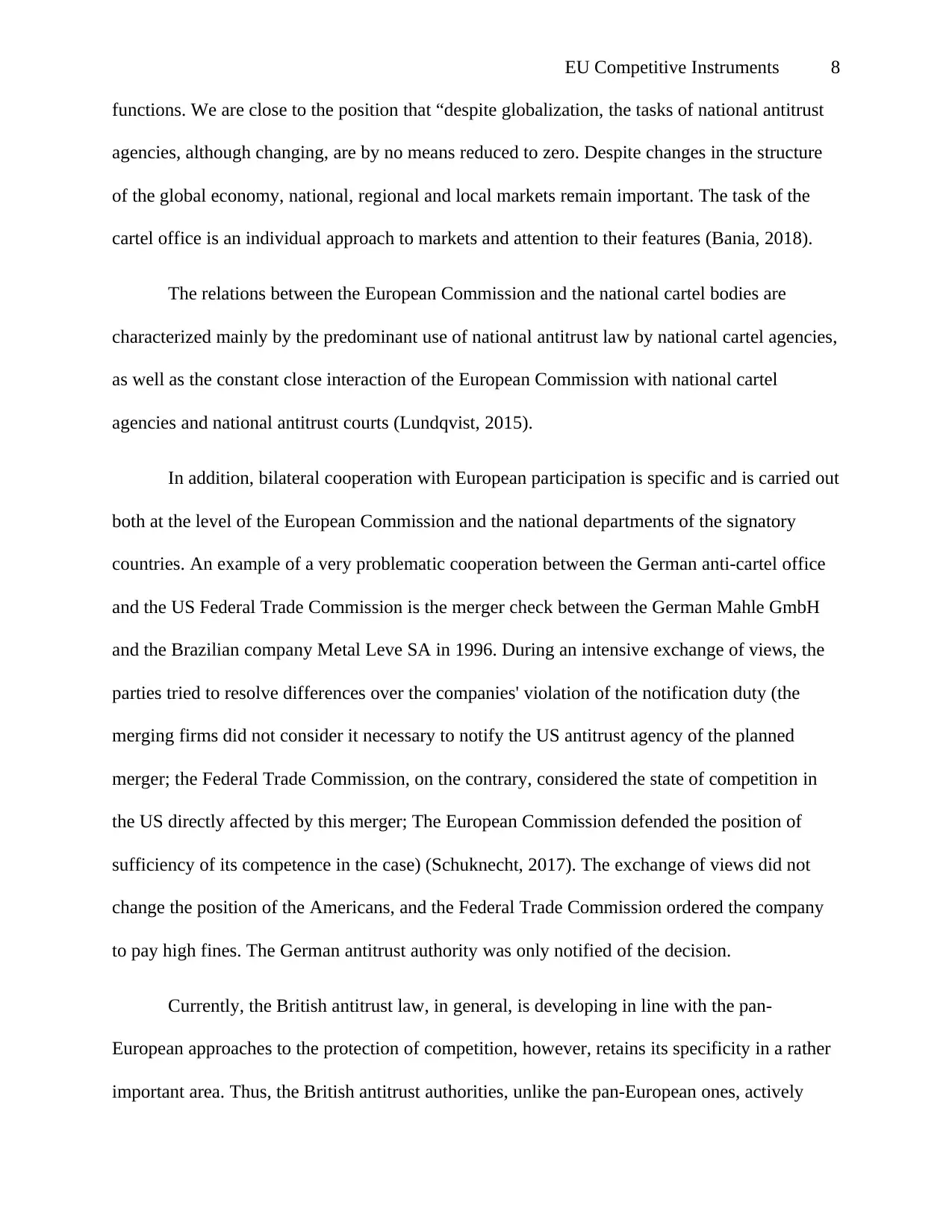
EU Competitive Instruments 8
functions. We are close to the position that “despite globalization, the tasks of national antitrust
agencies, although changing, are by no means reduced to zero. Despite changes in the structure
of the global economy, national, regional and local markets remain important. The task of the
cartel office is an individual approach to markets and attention to their features (Bania, 2018).
The relations between the European Commission and the national cartel bodies are
characterized mainly by the predominant use of national antitrust law by national cartel agencies,
as well as the constant close interaction of the European Commission with national cartel
agencies and national antitrust courts (Lundqvist, 2015).
In addition, bilateral cooperation with European participation is specific and is carried out
both at the level of the European Commission and the national departments of the signatory
countries. An example of a very problematic cooperation between the German anti-cartel office
and the US Federal Trade Commission is the merger check between the German Mahle GmbH
and the Brazilian company Metal Leve SA in 1996. During an intensive exchange of views, the
parties tried to resolve differences over the companies' violation of the notification duty (the
merging firms did not consider it necessary to notify the US antitrust agency of the planned
merger; the Federal Trade Commission, on the contrary, considered the state of competition in
the US directly affected by this merger; The European Commission defended the position of
sufficiency of its competence in the case) (Schuknecht, 2017). The exchange of views did not
change the position of the Americans, and the Federal Trade Commission ordered the company
to pay high fines. The German antitrust authority was only notified of the decision.
Currently, the British antitrust law, in general, is developing in line with the pan-
European approaches to the protection of competition, however, retains its specificity in a rather
important area. Thus, the British antitrust authorities, unlike the pan-European ones, actively
functions. We are close to the position that “despite globalization, the tasks of national antitrust
agencies, although changing, are by no means reduced to zero. Despite changes in the structure
of the global economy, national, regional and local markets remain important. The task of the
cartel office is an individual approach to markets and attention to their features (Bania, 2018).
The relations between the European Commission and the national cartel bodies are
characterized mainly by the predominant use of national antitrust law by national cartel agencies,
as well as the constant close interaction of the European Commission with national cartel
agencies and national antitrust courts (Lundqvist, 2015).
In addition, bilateral cooperation with European participation is specific and is carried out
both at the level of the European Commission and the national departments of the signatory
countries. An example of a very problematic cooperation between the German anti-cartel office
and the US Federal Trade Commission is the merger check between the German Mahle GmbH
and the Brazilian company Metal Leve SA in 1996. During an intensive exchange of views, the
parties tried to resolve differences over the companies' violation of the notification duty (the
merging firms did not consider it necessary to notify the US antitrust agency of the planned
merger; the Federal Trade Commission, on the contrary, considered the state of competition in
the US directly affected by this merger; The European Commission defended the position of
sufficiency of its competence in the case) (Schuknecht, 2017). The exchange of views did not
change the position of the Americans, and the Federal Trade Commission ordered the company
to pay high fines. The German antitrust authority was only notified of the decision.
Currently, the British antitrust law, in general, is developing in line with the pan-
European approaches to the protection of competition, however, retains its specificity in a rather
important area. Thus, the British antitrust authorities, unlike the pan-European ones, actively
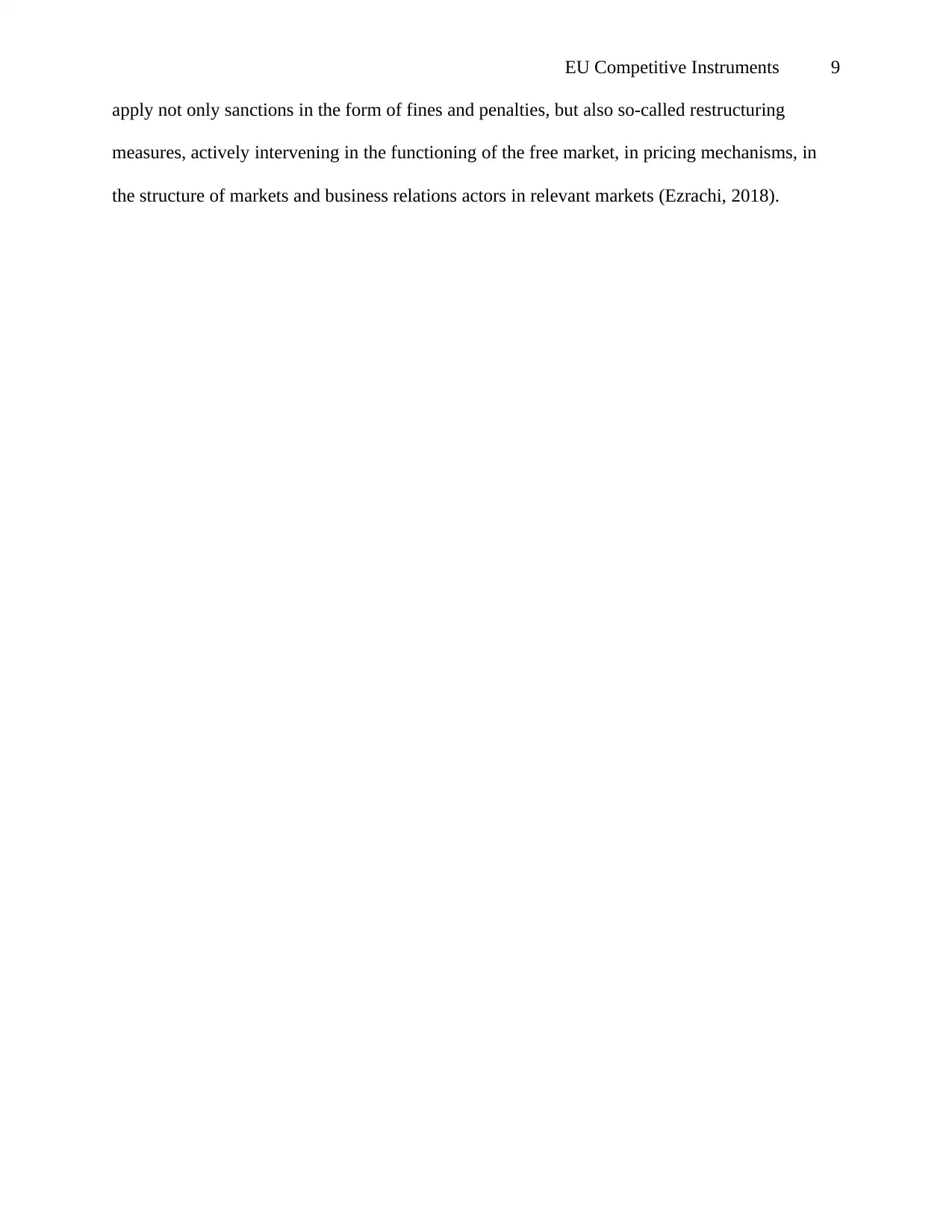
EU Competitive Instruments 9
apply not only sanctions in the form of fines and penalties, but also so-called restructuring
measures, actively intervening in the functioning of the free market, in pricing mechanisms, in
the structure of markets and business relations actors in relevant markets (Ezrachi, 2018).
apply not only sanctions in the form of fines and penalties, but also so-called restructuring
measures, actively intervening in the functioning of the free market, in pricing mechanisms, in
the structure of markets and business relations actors in relevant markets (Ezrachi, 2018).
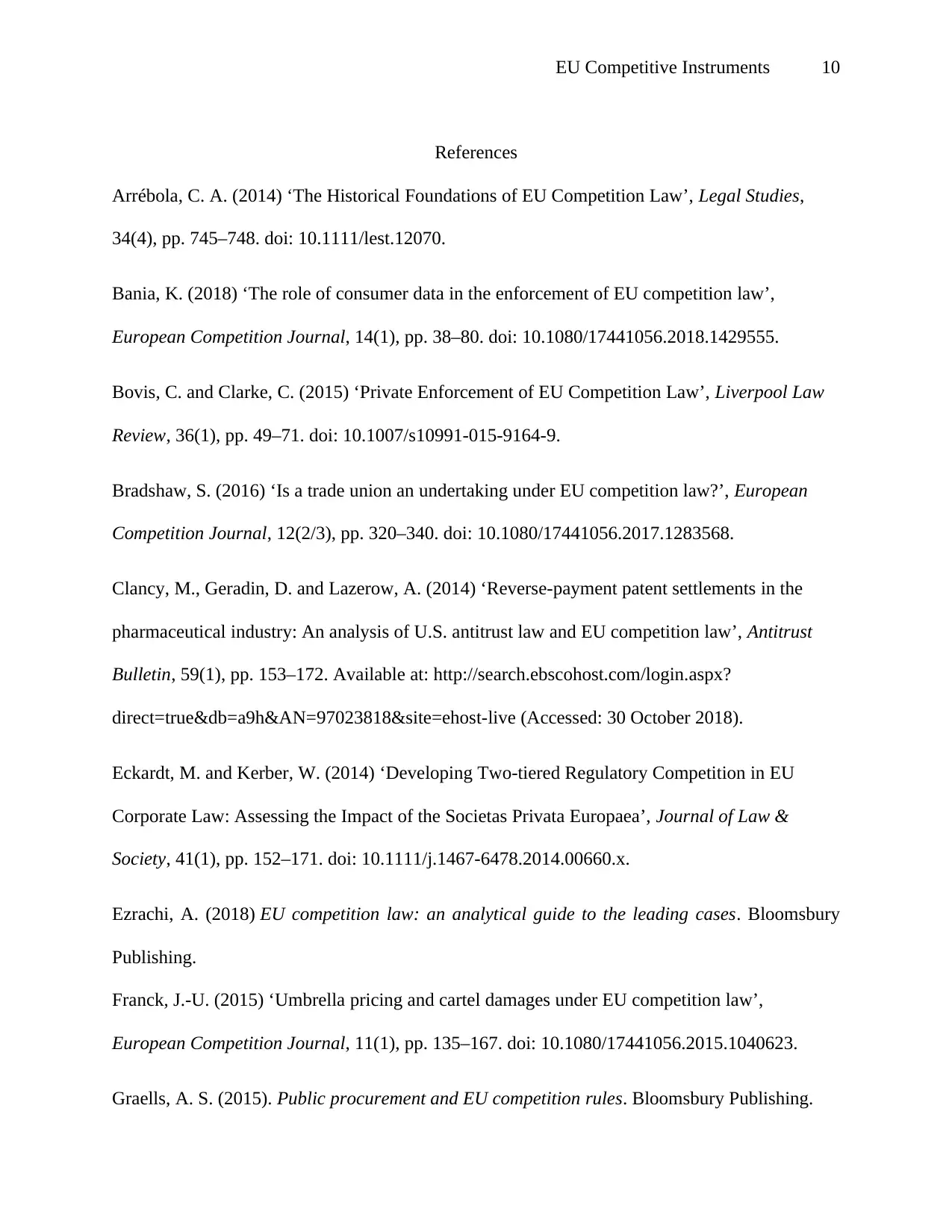
EU Competitive Instruments 10
References
Arrébola, C. A. (2014) ‘The Historical Foundations of EU Competition Law’, Legal Studies,
34(4), pp. 745–748. doi: 10.1111/lest.12070.
Bania, K. (2018) ‘The role of consumer data in the enforcement of EU competition law’,
European Competition Journal, 14(1), pp. 38–80. doi: 10.1080/17441056.2018.1429555.
Bovis, C. and Clarke, C. (2015) ‘Private Enforcement of EU Competition Law’, Liverpool Law
Review, 36(1), pp. 49–71. doi: 10.1007/s10991-015-9164-9.
Bradshaw, S. (2016) ‘Is a trade union an undertaking under EU competition law?’, European
Competition Journal, 12(2/3), pp. 320–340. doi: 10.1080/17441056.2017.1283568.
Clancy, M., Geradin, D. and Lazerow, A. (2014) ‘Reverse-payment patent settlements in the
pharmaceutical industry: An analysis of U.S. antitrust law and EU competition law’, Antitrust
Bulletin, 59(1), pp. 153–172. Available at: http://search.ebscohost.com/login.aspx?
direct=true&db=a9h&AN=97023818&site=ehost-live (Accessed: 30 October 2018).
Eckardt, M. and Kerber, W. (2014) ‘Developing Two-tiered Regulatory Competition in EU
Corporate Law: Assessing the Impact of the Societas Privata Europaea’, Journal of Law &
Society, 41(1), pp. 152–171. doi: 10.1111/j.1467-6478.2014.00660.x.
Ezrachi, A. (2018) EU competition law: an analytical guide to the leading cases. Bloomsbury
Publishing.
Franck, J.-U. (2015) ‘Umbrella pricing and cartel damages under EU competition law’,
European Competition Journal, 11(1), pp. 135–167. doi: 10.1080/17441056.2015.1040623.
Graells, A. S. (2015). Public procurement and EU competition rules. Bloomsbury Publishing.
References
Arrébola, C. A. (2014) ‘The Historical Foundations of EU Competition Law’, Legal Studies,
34(4), pp. 745–748. doi: 10.1111/lest.12070.
Bania, K. (2018) ‘The role of consumer data in the enforcement of EU competition law’,
European Competition Journal, 14(1), pp. 38–80. doi: 10.1080/17441056.2018.1429555.
Bovis, C. and Clarke, C. (2015) ‘Private Enforcement of EU Competition Law’, Liverpool Law
Review, 36(1), pp. 49–71. doi: 10.1007/s10991-015-9164-9.
Bradshaw, S. (2016) ‘Is a trade union an undertaking under EU competition law?’, European
Competition Journal, 12(2/3), pp. 320–340. doi: 10.1080/17441056.2017.1283568.
Clancy, M., Geradin, D. and Lazerow, A. (2014) ‘Reverse-payment patent settlements in the
pharmaceutical industry: An analysis of U.S. antitrust law and EU competition law’, Antitrust
Bulletin, 59(1), pp. 153–172. Available at: http://search.ebscohost.com/login.aspx?
direct=true&db=a9h&AN=97023818&site=ehost-live (Accessed: 30 October 2018).
Eckardt, M. and Kerber, W. (2014) ‘Developing Two-tiered Regulatory Competition in EU
Corporate Law: Assessing the Impact of the Societas Privata Europaea’, Journal of Law &
Society, 41(1), pp. 152–171. doi: 10.1111/j.1467-6478.2014.00660.x.
Ezrachi, A. (2018) EU competition law: an analytical guide to the leading cases. Bloomsbury
Publishing.
Franck, J.-U. (2015) ‘Umbrella pricing and cartel damages under EU competition law’,
European Competition Journal, 11(1), pp. 135–167. doi: 10.1080/17441056.2015.1040623.
Graells, A. S. (2015). Public procurement and EU competition rules. Bloomsbury Publishing.
Secure Best Marks with AI Grader
Need help grading? Try our AI Grader for instant feedback on your assignments.
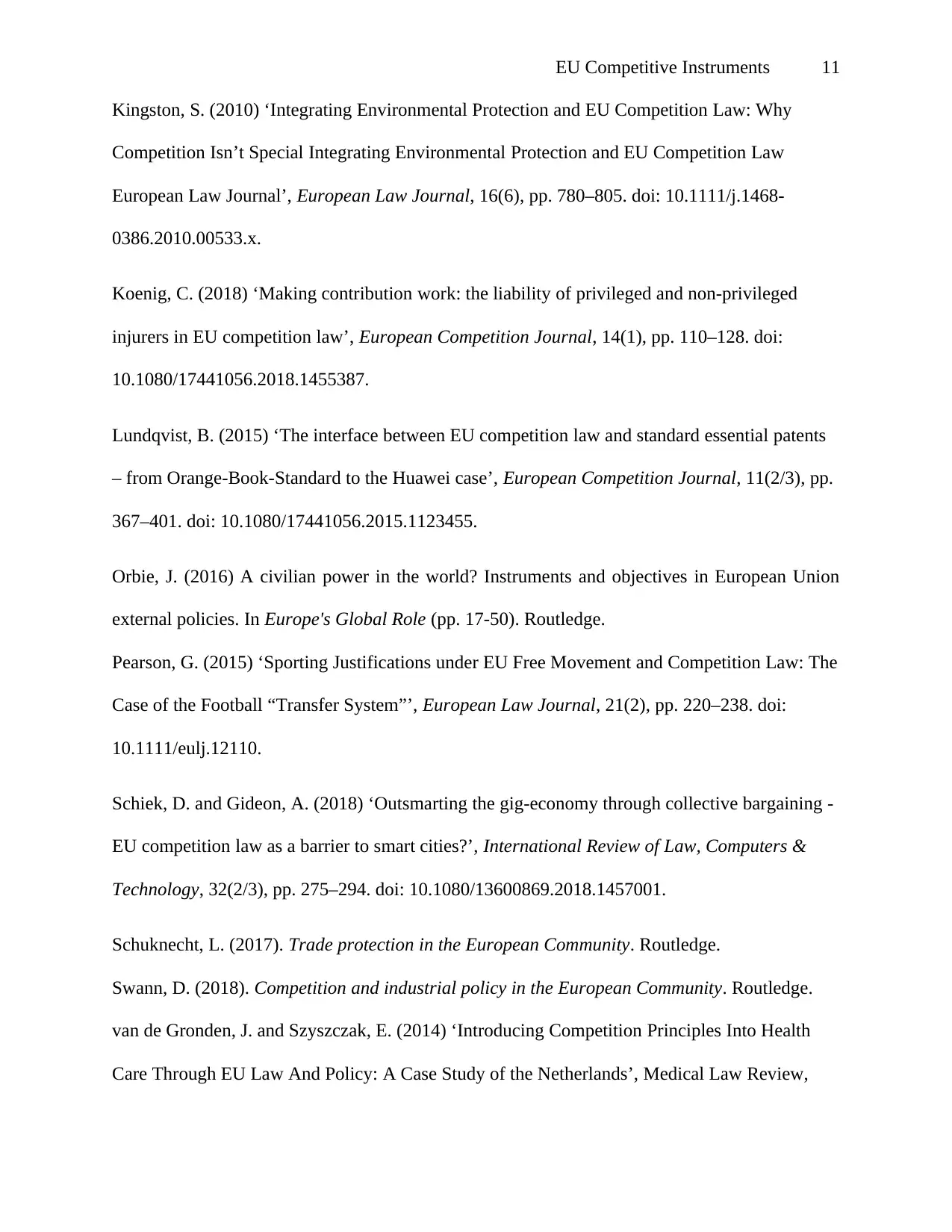
EU Competitive Instruments 11
Kingston, S. (2010) ‘Integrating Environmental Protection and EU Competition Law: Why
Competition Isn’t Special Integrating Environmental Protection and EU Competition Law
European Law Journal’, European Law Journal, 16(6), pp. 780–805. doi: 10.1111/j.1468-
0386.2010.00533.x.
Koenig, C. (2018) ‘Making contribution work: the liability of privileged and non-privileged
injurers in EU competition law’, European Competition Journal, 14(1), pp. 110–128. doi:
10.1080/17441056.2018.1455387.
Lundqvist, B. (2015) ‘The interface between EU competition law and standard essential patents
– from Orange-Book-Standard to the Huawei case’, European Competition Journal, 11(2/3), pp.
367–401. doi: 10.1080/17441056.2015.1123455.
Orbie, J. (2016) A civilian power in the world? Instruments and objectives in European Union
external policies. In Europe's Global Role (pp. 17-50). Routledge.
Pearson, G. (2015) ‘Sporting Justifications under EU Free Movement and Competition Law: The
Case of the Football “Transfer System”’, European Law Journal, 21(2), pp. 220–238. doi:
10.1111/eulj.12110.
Schiek, D. and Gideon, A. (2018) ‘Outsmarting the gig-economy through collective bargaining -
EU competition law as a barrier to smart cities?’, International Review of Law, Computers &
Technology, 32(2/3), pp. 275–294. doi: 10.1080/13600869.2018.1457001.
Schuknecht, L. (2017). Trade protection in the European Community. Routledge.
Swann, D. (2018). Competition and industrial policy in the European Community. Routledge.
van de Gronden, J. and Szyszczak, E. (2014) ‘Introducing Competition Principles Into Health
Care Through EU Law And Policy: A Case Study of the Netherlands’, Medical Law Review,
Kingston, S. (2010) ‘Integrating Environmental Protection and EU Competition Law: Why
Competition Isn’t Special Integrating Environmental Protection and EU Competition Law
European Law Journal’, European Law Journal, 16(6), pp. 780–805. doi: 10.1111/j.1468-
0386.2010.00533.x.
Koenig, C. (2018) ‘Making contribution work: the liability of privileged and non-privileged
injurers in EU competition law’, European Competition Journal, 14(1), pp. 110–128. doi:
10.1080/17441056.2018.1455387.
Lundqvist, B. (2015) ‘The interface between EU competition law and standard essential patents
– from Orange-Book-Standard to the Huawei case’, European Competition Journal, 11(2/3), pp.
367–401. doi: 10.1080/17441056.2015.1123455.
Orbie, J. (2016) A civilian power in the world? Instruments and objectives in European Union
external policies. In Europe's Global Role (pp. 17-50). Routledge.
Pearson, G. (2015) ‘Sporting Justifications under EU Free Movement and Competition Law: The
Case of the Football “Transfer System”’, European Law Journal, 21(2), pp. 220–238. doi:
10.1111/eulj.12110.
Schiek, D. and Gideon, A. (2018) ‘Outsmarting the gig-economy through collective bargaining -
EU competition law as a barrier to smart cities?’, International Review of Law, Computers &
Technology, 32(2/3), pp. 275–294. doi: 10.1080/13600869.2018.1457001.
Schuknecht, L. (2017). Trade protection in the European Community. Routledge.
Swann, D. (2018). Competition and industrial policy in the European Community. Routledge.
van de Gronden, J. and Szyszczak, E. (2014) ‘Introducing Competition Principles Into Health
Care Through EU Law And Policy: A Case Study of the Netherlands’, Medical Law Review,
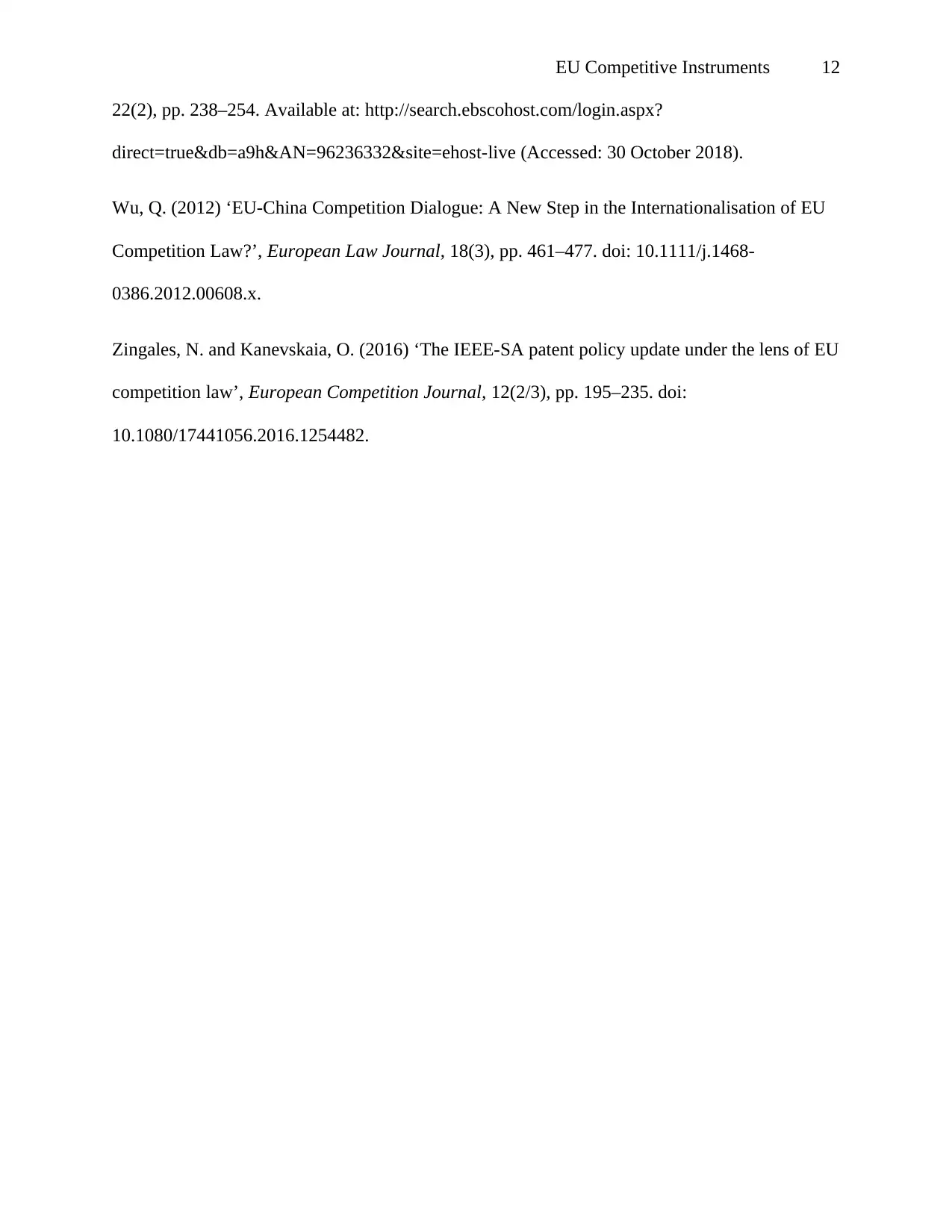
EU Competitive Instruments 12
22(2), pp. 238–254. Available at: http://search.ebscohost.com/login.aspx?
direct=true&db=a9h&AN=96236332&site=ehost-live (Accessed: 30 October 2018).
Wu, Q. (2012) ‘EU-China Competition Dialogue: A New Step in the Internationalisation of EU
Competition Law?’, European Law Journal, 18(3), pp. 461–477. doi: 10.1111/j.1468-
0386.2012.00608.x.
Zingales, N. and Kanevskaia, O. (2016) ‘The IEEE-SA patent policy update under the lens of EU
competition law’, European Competition Journal, 12(2/3), pp. 195–235. doi:
10.1080/17441056.2016.1254482.
22(2), pp. 238–254. Available at: http://search.ebscohost.com/login.aspx?
direct=true&db=a9h&AN=96236332&site=ehost-live (Accessed: 30 October 2018).
Wu, Q. (2012) ‘EU-China Competition Dialogue: A New Step in the Internationalisation of EU
Competition Law?’, European Law Journal, 18(3), pp. 461–477. doi: 10.1111/j.1468-
0386.2012.00608.x.
Zingales, N. and Kanevskaia, O. (2016) ‘The IEEE-SA patent policy update under the lens of EU
competition law’, European Competition Journal, 12(2/3), pp. 195–235. doi:
10.1080/17441056.2016.1254482.
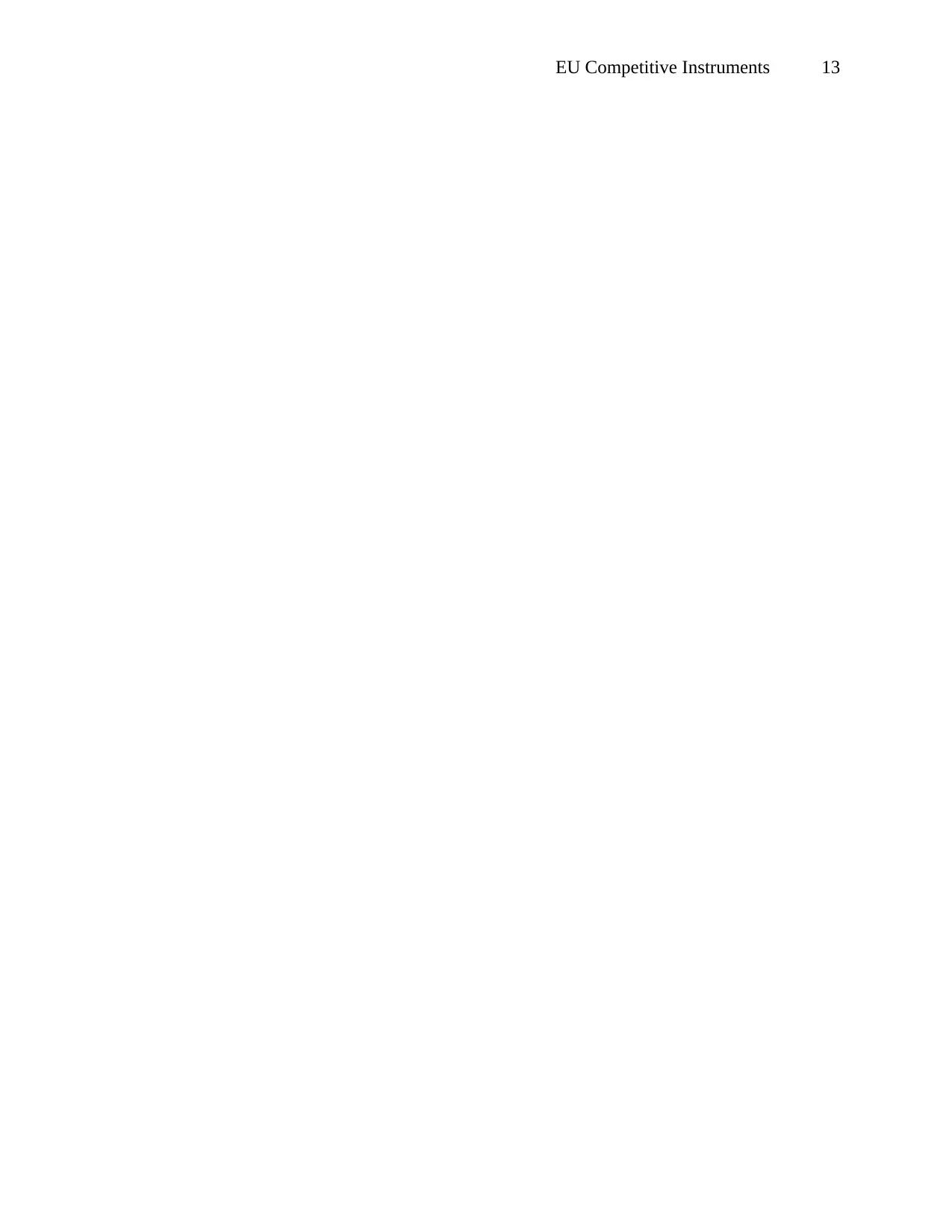
EU Competitive Instruments 13
1 out of 13
Related Documents
Your All-in-One AI-Powered Toolkit for Academic Success.
+13062052269
info@desklib.com
Available 24*7 on WhatsApp / Email
![[object Object]](/_next/static/media/star-bottom.7253800d.svg)
Unlock your academic potential
© 2024 | Zucol Services PVT LTD | All rights reserved.





